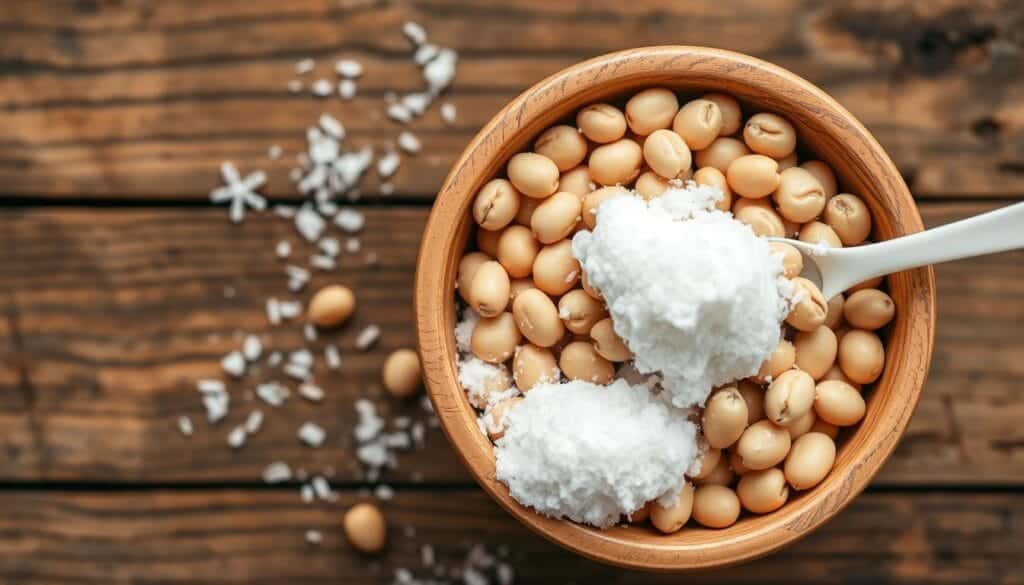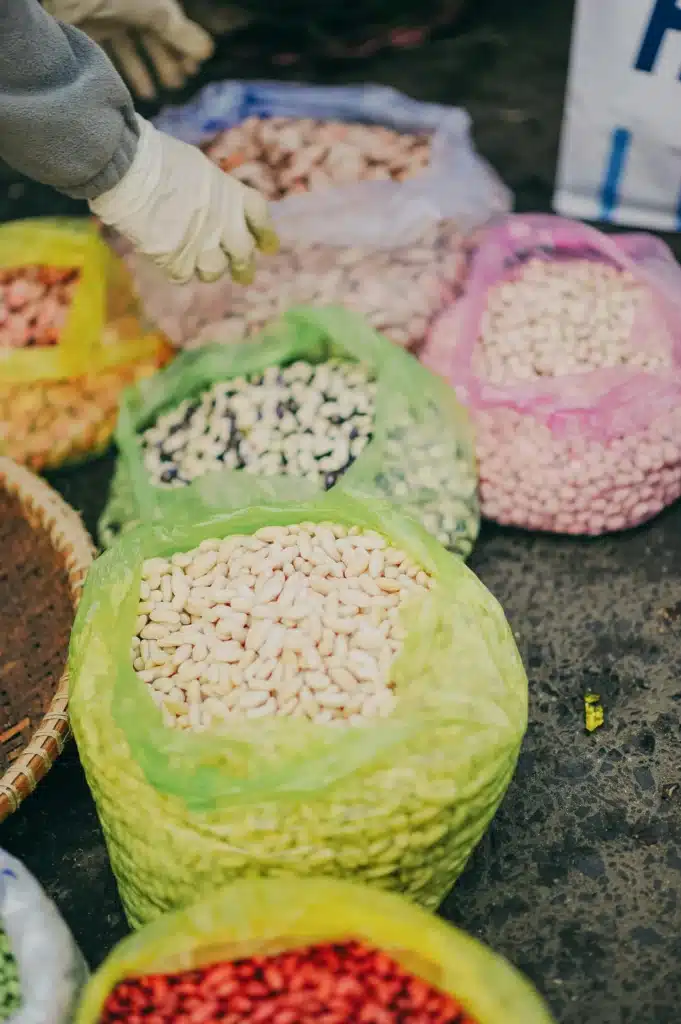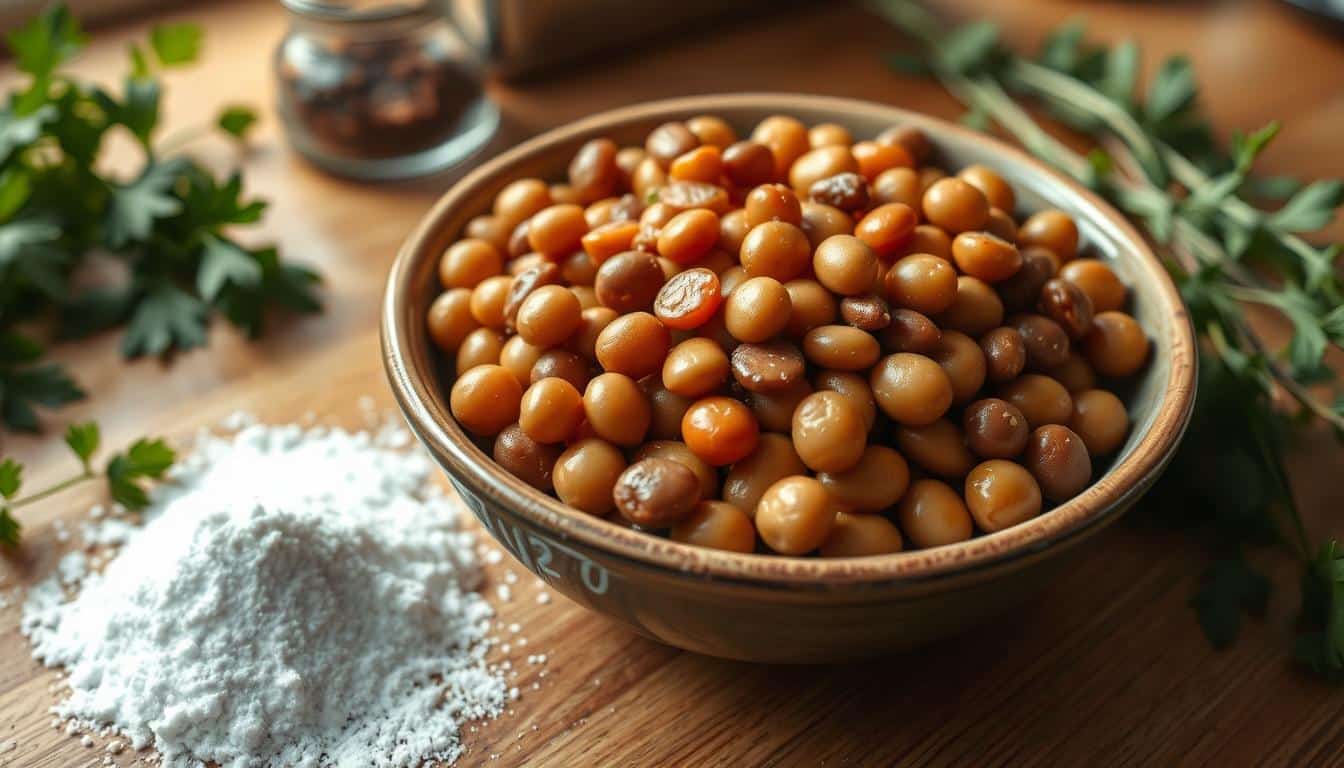Why add baking soda to beans? Ever had a bean dish that left you feeling bloated and uncomfortable? You’re not alone. Adding baking soda to your beans might be the secret to a better bean experience.
Beans are full of fiber and protein, but they can also upset your stomach. Baking soda can help with this problem. It breaks down sugars in beans that cause gas and bloating.
Adding a bit of baking soda can make beans easier to digest. This makes your meals not only tasty but also better for your stomach.
Understanding Baking Soda and Its Function
Baking soda is a kitchen superhero that can transform your cooking, making beans better. This simple white powder has amazing culinary powers. It’s not just for baking.

What Is Baking Soda?
Sodium bicarbonate, known as baking soda, is a natural alkaline compound. It’s a white, powdery substance that acts as a powerful cooking agent. Adding baking soda to beans makes them better in texture and easier to digest.
How Does Baking Soda Work?
Understanding baking soda’s magic is key. It works by:
- Neutralizing acid components
- Breaking down complex carbohydrates
- Softening bean cell walls
- Reducing cooking time
Common Uses in Cooking
Baking soda isn’t just for beans. It’s used in many ways:
- Tenderizing meat
- Creating crispy surfaces on baked goods
- Balancing flavors in savory dishes
- Improving bean cooking performance
“Baking soda is like a culinary magic wand that transforms ordinary ingredients into extraordinary meals.”
Knowing its properties can help you improve your cooking. It makes bean preparation easy.
The Science Behind Cooking Beans
Beans are more than just a food item. They are packed with nutrients and unique traits that affect how we digest them and cook them.

Nutritional Composition of Beans
Beans have complex molecules that test our digestive system. They are full of oligosaccharides, which are complex sugars our bodies can’t fully break down.
- High in protein (7-9 grams per 1/2 cup serving)
- Contains essential fiber
- Packed with important minerals
The Role of pH in Bean Cooking
Using baking soda with beans is all about pH levels. Baking soda makes the cooking environment alkaline. This can help break down bean cell walls, making them easier to digest.
“Baking soda can increase alkalinity in the cooking process, helping to break down bean skins faster.” – Culinary Nutrition Expert
Does baking soda make beans easier to digest? Yes, it does. By changing the cooking environment, baking soda can reduce the oligosaccharides that cause gas and discomfort.
- Recommended baking soda: 1/8 to 1/4 teaspoon per cup of dried beans
- Helps break down complex sugars
- Potentially reduces gas-producing compounds
Learning about these scientific principles can change how you cook beans. It makes your meals more digestible and fun to eat.
Benefits of Adding Baking Soda to Beans
Cooking beans can be tough, but baking soda makes it easier. It does more than just soften beans.
Softening Beans Quickly
Baking soda makes beans soft fast. A little baking soda in water speeds up softening. It breaks down bean cell walls, making them tender.
- Reduces soaking time dramatically
- Creates a more uniform texture
- Helps beans absorb flavors more effectively
Reducing Cooking Time
Beans usually take 1-2 hours to cook. Baking soda can cut this time. It changes water’s alkalinity, making beans tender faster.
Pro tip: Use just a small pinch of baking soda – too much can affect the bean’s flavor and texture.
Enhancing Digestibility
Baking soda also makes beans easier to digest. It breaks down sugars that cause gas and bloating. This leads to better digestion and less discomfort after eating beans.
- Reduces gas-causing compounds
- Makes beans easier to digest
- Helps maintain nutritional value
Adding baking soda to your bean prep brings convenience and comfort.
How to Properly Use Baking Soda with Beans
Cooking beans can be tricky, but adding baking soda makes them easier to digest and tender. Learning how to use baking soda with beans can change your cooking for the better.
The adding baking soda to beans method needs careful attention. Here’s a detailed guide to help you get it right:
Recommended Amounts for Perfect Beans
When using baking soda with beans, precision is key. Follow these guidelines:
- Use 1/8 to 1/4 teaspoon of baking soda per cup of dried beans
- Start with a smaller amount if you’re new to this method
- Avoid using too much, as it can affect the bean’s taste and texture
Optimal Timing for Adding Baking Soda
You have two main ways to add baking soda to your beans:
- Soaking Method:
- Add baking soda during the 8-12 hour soaking process
- Helps break down complex carbohydrates
- Reduces gas-producing compounds
- Cooking Method:
- Sprinkle baking soda directly into cooking water
- Works best for beans with tougher outer skins
- Can reduce cooking time
“Mastering the baking soda technique can turn ordinary beans into a culinary delight!” – Cooking Enthuasiasts
Remember, practice makes perfect. Each bean variety might need slight adjustments. Don’t be afraid to experiment and find what works best for your recipe.
The Relationship Between Baking Soda and Bean Color
Cooking beans is an art that requires care, like keeping their color bright. Understanding why add baking soda to beans is essential, as it can significantly impact the cooking process. Adding baking soda to beans not only helps maintain their vibrant color but also reduces cooking time and improves their texture. Knowing why add baking soda to beans can also help avoid potential changes in taste and appearance, ensuring a delicious and visually appealing dish every time.
Baking soda is key for keeping beans colorful. It creates an alkaline environment. This helps beans stay bright and appealing.
Preserving Bright Colors
To keep beans looking great, follow these tips:
- Use minimal amounts of baking soda
- Monitor cooking time carefully
- Choose fresh, high-quality beans
Avoiding Darkened Beans
Why use baking soda for beans? It’s all about balance. Too much can make beans dark and discolored.
“The right amount of baking soda can transform your beans from dull to dazzling” – Culinary Expert
Chefs suggest using 1/8 to 1/4 teaspoon of baking soda per cup of dried beans. This small amount keeps colors bright and prevents darkening.
Potential Downsides of Using Baking Soda
Baking soda can help with digesting beans, which is one reason why adding baking soda to beans is a popular practice. However, it’s important to use it sparingly, as too much baking soda can lower the quality and nutrition of your beans. Understanding why add baking soda to beans ensures you strike the right balance for better digestion without compromising on taste or health.
Taste and Texture Concerns
Too much baking soda can change the taste and texture of your beans. It can make them mushy and taste metallic. This is not what you want.
- Potential texture changes: Overly soft beans
- Flavor disruption: Metallic or bitter taste
- Unpleasant cooking outcome: Loss of bean integrity
Nutritional Considerations
Baking soda can help with digestion, but it might affect the nutrition of your beans. Some research shows that too much alkalinity can reduce some nutrients.
Moderation is key when using baking soda for cooking beans.
Here are some safe usage tips:
- Use only 1/8 to 1/4 teaspoon per cup of dried beans
- Monitor bean texture during cooking
- Avoid prolonged exposure to baking soda
Remember, a little baking soda goes a long way in improving bean digestibility without compromising taste or nutrition.
Alternatives to Baking Soda for Cooking Beans
Wondering why add baking soda to beans? There are other ways to make legumes soft and easy to digest. Many people don’t like using baking soda, and there are good alternatives.
Other cooking methods can do the same job as baking soda. They help break down sugars and cut down cooking time.
Soaking Techniques
Soaking is a great way to prepare beans. Here are some methods:
- Traditional overnight soak for 8-12 hours
- Fast soak method taking just 1 hour
- Using warm water to speed up soaking
Advanced Cooking Methods
There are other ways to make beans better:
- Pressure cooking to save time
- Using digestive enzyme supplements
- Slow cooking at low temperatures
“The key to perfect beans lies not just in baking soda, but in understanding proper preparation techniques.” – Culinary Expert
Each method has its own benefits. They help break down sugars and make beans easier to digest. Your choice depends on your time and what you have to cook with.
Recipes That Benefit From Baking Soda
Exploring new ways to cook with beans can change your cooking game. Understanding why add baking soda to beans is key to improving both classic and modern recipes. Adding baking soda to beans can enhance their flavor, make them easier to digest, and simplify the cooking process, taking your dishes to the next level.
Classic Bean Dishes That Shine
Traditional recipes can become amazing with the right baking soda technique. Some top dishes include:
- Black-Eyed Pea Soup With Ham Hocks
- Instant Pot Black-Eyed Peas
- Classic Hoppin’ John
These recipes get a big boost from baking soda. It breaks down carbs and makes beans tender and smooth.
Creative Bean Snacks and Innovations
Bean-based snacks can also benefit from baking soda. Try these creative ideas:
- Crispy bean fritters
- Smooth hummus variations
- Creamy bean dips
“Cooking beans with baking soda transforms ordinary legumes into culinary masterpieces.”
Using baking soda cuts cooking time and makes beans easier to digest. It also makes your dishes more appealing and enjoyable for all.
Conclusion: Making the Most of Your Beans
Adding baking soda to beans can change how you cook. It does more than just prepare food. It makes beans softer, easier to digest, and more flavorful.
Key Takeaways
Using baking soda in bean cooking does more than soften them. It breaks down sugars that can upset your stomach. Studies show a little baking soda can cut down on bloating and gas.
Final Thoughts on Baking Soda Usage
Bean cooking doesn’t have to be hard. Trying baking soda can help you find the right mix for your recipes. Just a small amount can improve texture and digestion without losing bean nutrition.
With these tips, you’ll cook with more confidence. You’ll turn simple beans into tasty, healthy meals for everyone.
FAQ
Why should I add baking soda to beans?
Baking soda softens beans quickly, saving time. It also makes beans easier to digest by breaking down sugars that cause gas and discomfort.
How much baking soda should I use when cooking beans?
Use about 1/8 to 1/4 teaspoon of baking soda per pound of beans. Too much can ruin the taste and texture.
Does baking soda really make beans easier to digest?
Yes, baking soda breaks down sugars that cause gas and bloating. It creates an alkaline environment that helps digest these sugars better.
When should I add baking soda to beans?
Add baking soda during soaking or at the start of cooking. For soaking, mix it with water first. For cooking, add it to the water at the beginning.
Will baking soda change the color of my beans?
Baking soda can preserve the colors of some beans. But too much or wrong use can darken or soften them too much.
Are there any drawbacks to using baking soda with beans?
Too much baking soda can make beans mushy and change their taste. It might also reduce their nutritional value.
Can I use something else instead of baking soda?
Yes, you can use kombu, acidic ingredients, or different cooking methods to make beans easier to digest.
Does baking soda work with all types of beans?
Baking soda works well with most beans. It’s best for older, drier beans that are harder to cook.
Can I add baking soda to canned beans?
No, you don’t need baking soda for canned beans. It’s used for dried beans during soaking and cooking.
Is baking soda safe to use when cooking beans?
Yes, baking soda is safe in moderation. It’s a common ingredient that can improve bean texture and digestibility.
